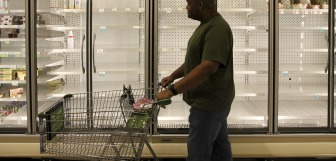What is Shrink (Shrinkage) in Retail?
This article tackles the issue of shrinkage in retail stores. Shrinkage is something that occurs, intentionally or unintentionally, in many businesses within the retail industry, and can cause a whole range of problems for managers and business owners. Learn how to detect it, and how to stop it for ultimate profitability and operational efficiency.
In this guide, we explore all there is to know about shrink in retail:
- Shrinkage definition
- Shrink examples and causes
- The effects of shrinkage
- How to calculate shrink in retail
- Loss prevention measures
What is shrink in retail?
Shrink is the loss of inventory caused by things like employee theft, employee error and damage, shoplifting, vendor fraud, and administrative errors. Shrinkage is the difference between the optimal sales profit from the expected stock levels and the actual profit earned from stock that was sold. It’s measured by the amount of money that was spent on inventory that’s been lost or is unsellable.
Shrinkage doesn’t just remove the opportunity to earn money due to missing stock. It costs extra money since the damaged or lost stock has to be replaced. It causes profit loss, and increases costs.
How does shrinkage occur?
The causes of shrink vary massively from store to store. The US National Retail Federation (NRF), who collect global shrinkage data, have collected 2020’s shrink data, and identified the most commonly reported reasons for shrink from the previous year.
- 36.5% is linked to shoplifting
- 30.0% is linked to employees (error, intentional and unintentional damage or loss)
- 21.3% is linked to administrative error
- 5.4% is linked to fraud
- The cause of the last 6.8% is unknown and unaccounted for
Turning to where shrinkage takes place, the NRF have also reported where fraud is most likely to occur to retail businesses. Brick and mortar, in-person sales surprisingly account for the majority, at 49.3% of overall shrink-related fraud. Next is online-only sales, at 26.1%. Finally multichannel and omnichannel sales, including click and collect, face an 18.8% fraud rate.
Clearly, measures must be taken against fraud across all channels. In-person theft and fraud are still the most prevalent. This might be because online and e-commerce sales and payments are deemed safer as they go through more security checks.
The National Retail Federation have also identified new threats and emerging areas of concern that retailers should look out for. These include:
- More attempts of theft without fear of consequences - the mindset that legal action will not be taken
- Gift card and voucher scams
- Merchandise theft in fitting rooms
- Self-checkouts and mobile checkouts [1]
The effects of shrinkage
The 2020 National Retail Survey found that shrinkage is at an all-time high, accounting for 1.62% of the average retailer’s bottom line. That’s costing the entire industry US$61.7 billion per year [2].
However, it impacts the entire business, including employees. If it’s discovered that an employee is causing retail shrink, either by stealing, by intentionally damaging inventory with the hopes of buying it for a lower price, or by facilitating shoplifting in collaboration with someone else, this can be extremely costly for businesses.
When business owners face shrinkage, they may resort to cutting employee hours or reducing wages to account for the loss. This means innocent employees are losing holidays, staff days, or are otherwise being sanctioned for the actions of others. In some cases, businesses may even have to make employees redundant or shut down completely if they can’t recover from intense shrinkage or shoplifting.
The average dollar loss per dishonest employee in 2019 was US$1,139.32 [3]. This figure only takes physical inventory losses into account: for example, theft, losses, or anything that can’t be sold.
As well as this, there are also costs associated with firing and rehiring employees. Including HR costs (if there is no in-house HR department), legal prosecution costs, dismissal case costs, and advertising and recruitment costs. Business owners may have to launch an investigation into the theft, as well as invest in loss prevention equipment and training for other employees.
Unfortunately, the damage doesn’t stop there. Low cash flow and shrinking profit margins might also lead business owners to increase their pricing, which negatively impacts customer relationships. Business owners may need to recalculate other budgets, such as the spending on marketing or growth, their security budget, not to mention stock purchasing and security.
It is incredibly important for retail businesses to prevent shrinkage in order to avoid these extreme consequences.
How to calculate shrink in retail
There is a simple formula to work out the cost of shrink in monetary terms:
Optimal retail revenue from merchandise - actual income after viable merchandise is sold = shrinkage
While shrink is measured in money lost, it’s most often expressed in terms of a percentage to company sales. The formula is as follows:
Total losses divided by total sales = retail shrink percentage
As mentioned, the current average shrink rate percentage for retail businesses is 1.62%. However, this is deemed as extremely high and can definitely cause huge damage to businesses.
Loss prevention
Actions taken to prevent shrinkage are known as loss prevention measures. For the best protection, businesses should take on as many loss prevention measures as possible, with multiple focus points.
Employees
Employees should always be an asset to business security, not a threat. Anti-shrinkage training should start from day one of employment. Bear in mind that it’s never too late to start, even with established employees.
Conduct regular training sessions on what to do in the case of a robbery or other emergency situations, as well as whistleblowing and procedures around reporting internal theft. Increase training around what to do if you think someone is acting suspiciously, or suspected of shoplifting or fraud.
Proper training on all workplace procedures will prevent shrinkage too. If employees are taught how to complete thorough inventory counts, for example, there is less room for error.
Customers
Unfortunately, some customers will have malicious intentions when engaging with retail businesses. Consider what payment methods to support carefully.
- If you accept cash, do you check for fake notes?
- If you take card payments, are your payment terminals PCI compliant?
- Does your merchant services provider offer any security measures?
- Are your gift card and returns policies fraud-proof?
- Do you have insurance against customer fraud?
- Do you have verification measures in place, that prove that customers have authorised payments, for example, chip-and-pin payments only?
Risk assessments
Carry out a risk assessment to discover any potential threats to security. Even if it seems unlikely, it’s never impossible for a crime to be committed against a business. Think of loss prevention equipment, technology, employee training, valuable stock storage, operational risks, monetary risks, and fraud opportunities.
Invest in loss prevention technology
The number one recommended way to prevent shrinkage, according to the US National Retail Federation, is a robust point of sale (POS) system. Epos Now Retail POS Software comes with a huge range of security features designed to keep retail shrinkage to a minimum.
Our multi-award-winning inventory management software updates stock levels with every sale entered into the POS, for the most accurate, real-time inventory level. The software also allows business owners to enter exact quantities and measurements into the POS for better inventory control.
You can also trade online using Epos Now. Allow customers to place orders on your website, accept payments, then send shipping updates to customers. Or, you can send tracked refunds for cancelled orders. Your POS will also have an advanced customer profile centre that tracks your customer’s shopping history, including cancelled and refunded orders, for better fraud detection.
There are also countless useful reports you can generate using Epos Now. These include single item performance per date, seasonal trends, sales per employee, and best and worst-selling items.
Fight back against lost profitability, and invest in software that is designed to protect and improve your business.




